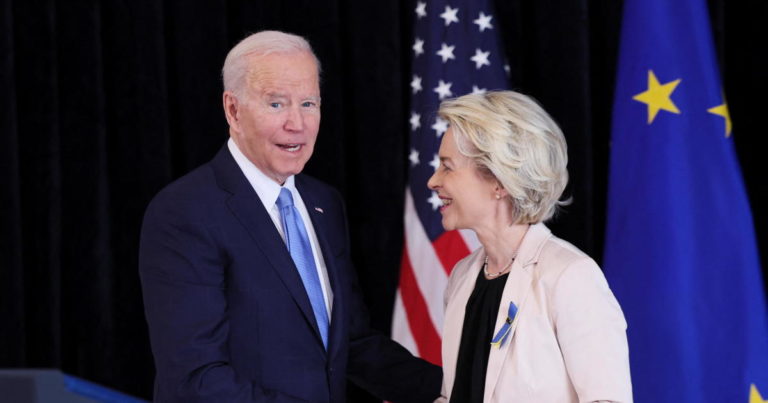
The U.S. and European Union announced a new task force on Friday aimed entirely at reducing Europe’s reliance on Russian gas in the face of Moscow’s war on Ukraine. The initiative unveiled in Brussels by President Joe Biden and EU chief Ursula von der Leyen will see the U.S. work with partners to strive to supply Europe with an extra 15 billion cubic meters of liquefied natural gas, or LNG, this year alone, they said.
The European Commission is to work with EU member nations to ensure they have infrastructure capable of receiving about 50 billion cubic meters, or bcm, of additional LNG until at least 2030, according to a factsheet provided by the White House. It was unclear whether that referred to amounts additional to last year’s 22 bcm of U.S. exports to the EU.
“This initiative focuses on two core issues, one helping Europe to reduce its dependency on Russian gas as quickly as possible and secondly, reducing Europe’s demand for gas overall,” Mr. Biden said at a joint news conference with von der Leyen.
“Today we’ve agreed on a joint game plan toward that goal while accelerating our progress toward a secure clean energy future,” he said.
EVELYN HOCKSTEIN / REUTERS
The agreement raises environmental concerns over the construction of new LNG terminals in the U.S. and Europe which, once built, will likely be in operation for years to come, the New York Times reported. Made from natural gas that is cooled and kept in liquid form for easier transportation, LNG is a form of fossil fuel.
“If the LNG export industry expands as projected, it is likely to make it nearly impossible to keep global temperatures from increasing above the 1.5 degrees Celsius threshold for catastrophic climate impacts,” the Natural Resources Defense Council said in a 2020 report on LNG and climate.
The task force initiative comes as EU member states wrangle over calls for the bloc to ban Russia’s key energy exports to punish President Vladimir Putin for his invasion of Ukraine. The Baltic countries and Poland are urging counterparts to do so. The EU has already announced ambitious plans to slash its imports of Russian gas by two-thirds this year and eliminate imports entirely before the end of the decade.
Germany, one of Russia’s biggest energy customers, is taking steps to speed up the building of terminals to receive liquefied natural gas. The economic powerhouse said Friday it was drastically slashing its energy purchases from Russia over Moscow’s invasion of Ukraine, with oil imports to be halved by June and coal deliveries to end by the autumn.
Mr. Biden stressed that while the significant increase in U.S. liquified natural gas deliveries to Europe were essential in the short to mid-term, as “we have to make sure families in Europe can get through this winter and next winter,” he did not see it derailing efforts to wean both the U.S. and Europe off fossil fuels in the longer term.
The crisis in Ukraine, Mr. Biden said, “presents an opportunity. It’s a catalyst to accelerate” the shift away from gas and coal power and toward a shared American and European carbon “net-zero future,” he said.
“I know eliminating Russian gas will have costs for Europe,” Mr. Biden said, “but it’s the right thing to do, and it will put us on a stronger strategic footing.”
As part of the task force the EU’s executive said the organization will work with member states “toward the goal of ensuring, until at least 2030, demand for approximately 50 bcm/year of additional US LNG”.
“This Task Force for Energy Security will be chaired by a representative from the White House and a representative of the President of the European Commission,” the leaders said Friday. “It will work to ensure energy security for Ukraine and the EU in preparation for next winter and the following one while supporting the EU’s goal to end its dependence on Russian fossil fuels.”
Europe faces a major task in substituting supplies of Russian gas, with Moscow supplying around 150 bcm of gas each year.
U.S. gas supplies to the EU accounted for just 6.3% in the first half of 2021, the bloc’s statistics agency says.
However, U.S. exports of LNG to Europe nearly doubled in January from November 2021 — making it the largest supplier of LNG imports to Europe for that month, ahead of Russia and Qatar, according to the U.S. Energy Information Association.
As U.S. LNG plants are already working to capacity, the Reuters news agency said analysts expect that most of the additional gas for Europe will have to come either from U.S. exports that are diverted from other parts of the world, or from other suppliers working in partnership with the U.S. to help meet Europe’s needs.